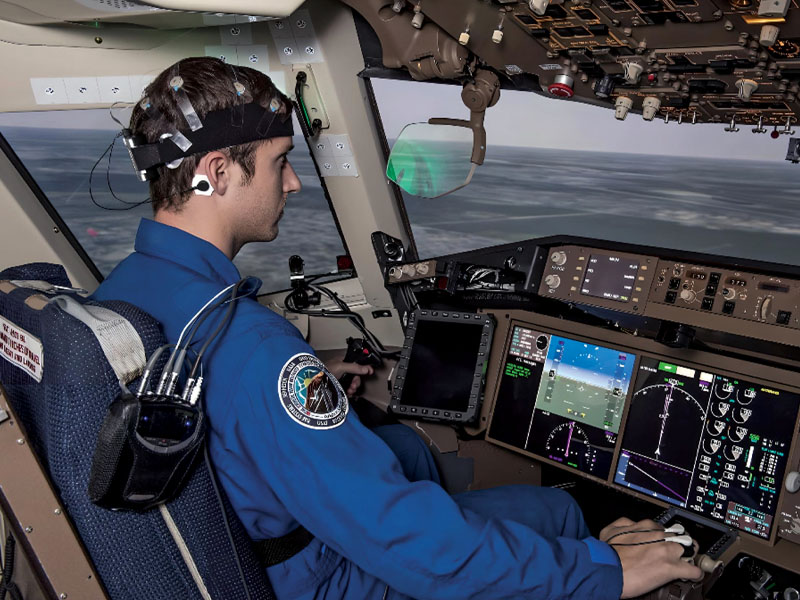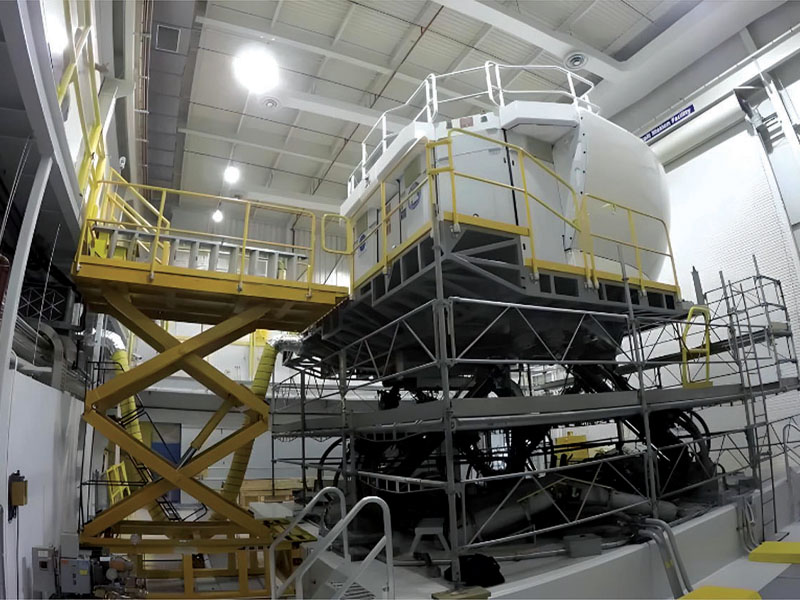The Important Data You Don‘t See
Human Contributions to Aviation Safety
By Human Contributions to Safety Team, NASA System-Wide Safety Project

Dr. Kyle Ellis from NASA’s System-Wide Safety project uses a flight simulator for research.
The demands and dynamics of the aviation environment present continuous challenges that flight crews must contend with, and they’re well trained to do so. Airline pilots spend a vast majority of their time proactively taking actions that create positive safety outcomes and that mitigate negative ones. The outstanding safety record of the U.S. airline industry is an enduring testament to the contributions of the airline pilots who dedicate themselves to safe operations day in and day out.
NASA fully believes that people, especially pilots, are the foundation of safety in aviation, employing their adaptive capabilities to anticipate, monitor for, respond to, and learn from what happens. It’s widely recognized that pilots consistently save the day by addressing a myriad of nonnormal situations such as equipment malfunctions and automation anomalies as well as other operational issues such as weather, air traffic demands, and avoiding potential runway incursions. Pilots also routinely deal with everyday threats and hazards that they successfully manage but that regularly go unnoticed or unremarked.
It’s critical to recognize and understand the ongoing and necessary human contributions to safety as new technologies and procedures are introduced. Humans adapt to these new changes, just like they routinely adjust for unexpected events every day. This means that if we truly want to understand the impact of a new technology or procedure, we can’t look solely at outcomes. Rather, we need to consider the process of what happens during everyday work. Did this new technology help pilots do their job or was human adaptation (such as using work-arounds) required? Either case might result in a successful outcome, but the effect on pilots and their workload could be very different. It’s important for organizations, policy makers, and system designers to recognize the positive and pivotal role that humans play in how the system operates—that “normal” operations happen because people are constantly adapting to keep things that way.
Let’s consider this more closely through a thought exercise. While accident analyses indicate that human error does occur, Line Operational Safety Audit (LOSA) data suggests that pilots intervene to manage aircraft malfunctions on 20 percent of “normal” flights. If we look at the worldwide jet data from 2007 to 2016, there were about 629,000 successful flights for every one that resulted in an accident. Now hold onto your flight manuals because here’s a surprising statistic: if we take these figures together, we can calculate that pilots intervened to keep flights safe more than 157,000 times for every time that one human error contributed to an accident! In other words, pilots cause safety every day.

The flight simulation facility at NASA Langley Research Center.
By focusing only on learning from what goes wrong, we’re missing opportunities to learn from what goes right—and things go right almost all the time. So let’s broaden our safety mindset to continuously learn from what may be a potential treasure trove of data. By looking at the data through various lenses, we can enrich our approach to safety. We need to understand not only the errors that reduce safety, but the desired behaviors that produce safety. Pilots do this every day flying the line and then fine-tuning their skills on the next flight. They see other pilot behaviors that they want to emulate, as well as behaviors they need to avoid. This allows them to evaluate how they might approach situations differently on future flights.
Federal aviation regulations for dealing with nonnormal and emergency situations recognize the safety-producing role of pilots. In the Code of Federal Regulations, Part 121.557(a) of Title 14 states, “In an emergency situation that requires immediate decision and action, the pilot in command may take any action that he considers necessary under the circumstances. In such a case, he may deviate from prescribed operations procedures and methods, weather minimums, and this chapter, to the extent required in the interests of safety.” However, this acknowledgment of pilots’ roles in producing safety is limited to rare emergency situations, and the role of pilots in routinely keeping everyday operations safe is largely unstudied and underrecognized. This is where NASA and our many partners, including ALPA pilot groups at airlines that participate in collaboration, are working together toward a better understanding of how pilots cause safety by learning from safety successes, not just safety failures.
One way NASA helps to improve aviation safety is by exploring ways to analyze and validate new forms of safety data, such as those that help us learn more about how flight crews adapt to changing situations during both routine and nonroutine flight operations. For example, researching different types of safety management system data can yield new safety insights, and the findings can be used to inform flight safety and training needs. Additionally, NASA is developing new data-mining capabilities, using advanced statistical and machine-learning data-analytics approaches, that can identify patterns across different sets of safety data. You’ll hear more about these data analytical approaches in a future article that describes how NASA and collaborative partners are working on new ways to use flight operations safety data to better understand what’s happening and why it’s happening.
ALPA is a leader for aviation safety. NASA’s airline industry partnerships and discussions with ALPA pilots and safety stakeholders enable NASA to explore new ways to learn about aviation safety. The impact that ALPA members have on safety—not just while performing their duties, but also through support of research and new initiatives—truly highlights the human contributions to aviation safety. Safe operations are possible thanks to you, the pilots out there flying the line every day.
Airline Pilots ‘Produce Safety’ Every Single Day
By Capt. Todd Lisak (JetBlue), Director, ALPA Human Factors & Training Group
What is human factors as applied to aviation? Taking a complex topic and putting it simply, human factors knowledge is used to optimize the fit between pilots and the systems in which they work. ALPA’s Human Factors & Training (HFT) Group advocates for the integration of human factors into all flight operations and training programs, aircraft design and certification, and standard operating procedures to improve safety and performance.
As airline pilots, we have a direct appreciation for the foundational role that pilot resiliency and adaptability have in affecting safe outcomes in our demanding environment. We strive for excellence every time we fly. This constant desire for improvement and attention to detail results in pilots “producing safety.” This concept, and the frequency with which it happens, is often lost behind the focus on what went wrong in rare but high-profile events. There’s seldom a news story about pilot decision-making or intervention that averted disaster, which is something pilots throughout the system do every single day. Failure to examine and share the strengths of pilot decision-making, indeed resiliency, that result in positive outcomes diminishes the opportunities to learn and continually improve upon a strong safety record. That’s why each year at our Air Safety Forum, ALPA recognizes flightcrew members who’ve averted disaster with our Superior Airmanship Award.
Yet resiliency alone isn’t enough. Adaptability is a uniquely human strength and an indispensable pilot trait. Advancements in aviation require pilots to perceive and process a wide array of system feedback and alerting presented in multiple formats. We must understand and adapt to system anomalies, system interface issues, and other unexpected behavior. Recognition of this demand for a continual state of cognitive processing and decision-making has been a game changer in the industry and its approach to safety-driven practices. By proactively adapting policies, procedures, and training, we more effectively leverage irreplaceable human strengths to further improve safety performance.
Understanding human factors provides crucial awareness in aviation. It enables us to harness the strengths and mitigate the limitations of human cognition to successfully handle flights where things don’t go as expected. On every flight, pilots hone their communication, CRM, threat and error management, and monitoring skills. The airline industry’s outstanding safety record happens because well trained, well rested, and professional pilots practice and produce safety on every single flight
As an industry, we strive to incorporate these human factors concepts throughout all aspects of the operation. ALPA’s HFT Group collaborates with other organizations to help share this pilot perspective in developing policy, practices, and technology. On the global level, HFT Group members are part of the International Federation of Air Line Pilots’ Associations Human Performance Committee and sit on International Civil Aviation Organization panels, such as the Personnel Training and Licensing Panel, to ensure that our voice is heard.
The safety of our skies reflects the relentless commitment of pilots. Our adaptability, resiliency, and drive for betterment aren’t just professional skills; they’re what keep us ahead. By living these values, we do more than fly aircraft—we embody and perpetuate the essence of aviation safety and excellence. ALPA’s HFT Group will continue to emphasize and advocate for the importance of pilot contributions to aviation safety throughout the group’s work.
Aviation Safety Standards and the Threat of Reduced-Crew Operations
While sophisticated technologies are continually being developed to support pilots in the performance of their duties, some within the airline industry have the misguided notion that technology alone can ensure the safety of flight operations. Although ill-advised, reducing the number of crewmembers on the flight deck is a serious threat, and the situation demands urgent and immediate action to defend the safety standards that ALPA and other safety advocates have fought so hard to achieve.
“Removing pilots from the flight deck will increase risk to the public and will place the safest mode of transportation in the world in jeopardy,” says Capt. Jason Ambrosi, ALPA’s president. “Some argue that, despite the safety risks, your future flight should be operated with fewer pilots on the flight deck. As an airline captain, I can tell you that’s insane.”
In response to this threat, ALPA, the European Cockpit Association, the International Federation of Air Line Pilots’ Associations, and three global pilot alliances launched a worldwide grassroots advocacy campaign, “Safety Starts with Two.” The campaign includes a website, a virtual toolkit for social media engagement, and a physical toolkit that includes bag tags, badge backers, and stickers—in Arabic, Chinese, English, French, and Spanish—for use by ALPA members and the global pilot community, including the Associations of Star Alliance Pilots, the Oneworld Cockpit Crew Coalition, and the SkyTeam Pilots Association, as a way to demonstrate their support and engage with members, local regulators, and legislators.
The greatest guarantee of safety on any airline flight is the presence of at least two highly trained pilots on the flight deck at all times. Join ALPA and its partners in spreading the message that Safety Starts with Two. For more information, contact Safetystartswith2@alpa.org.—Gavin Francis, Senior Aviation Writer

